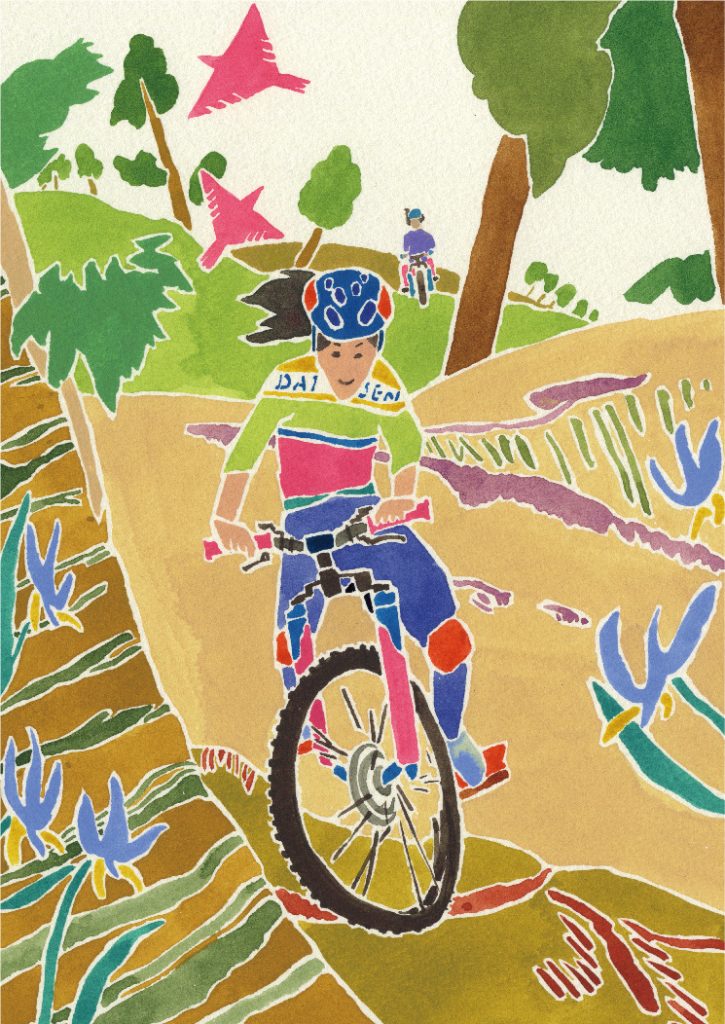Downhill Cycling

The words “Downhill Cycling” sounded very appealing to me as I do not exercise regularly.
Going downhill would not require tough uphill pedaling I thought; just riding and letting gravity do its work. And since I needed to feel a sense of achievement by doing something healthy and refreshing, I came to Mt. Daisen to experience downhill cycling.
I joined a cycling tour with no specific motives. However, even before hitting the road, I was overwhelmed by the presence of Mt. Daisen, the highest peak of Chugoku Region and one of the best 100 mountains in Japan. Its dignified look explains why the mountain has been a symbol of worship since ancient times.
I didn’t come here with this knowledge. This is what I learned from my bike instructor, Kuruma-san. I simply came here because I got a few days off and I wanted to be close to nature, which is something I cannot usually do.
What I imagined from the words “Downhill Cycling” was just going downhill by bike. I thought Kuruma-san would accompany us just to show us the way, but in fact, he gave us a lot of really interesting information at every key point.
As the tour started, I first realized the beauty of the scenery. Many things I’d never paid attention to came into sight. For me, who rarely walks and often uses trains or cars for transportation, the speed of a bike was comfortably slow and I could appreciate all the different colors of nature.
Many questions then came to mind, such as; “What is this?” “I’ve never seen this big tree before.” As if Kuruma-san had read my mind, he gave me answers to my questions while biking.
“This is a white clover. You probably have seen this before. It is an introduced species which arrived in Japan in Edo Period. It came from Holland, Japan’s trading partner at the time. Dried white clovers were used as cushioning material. That’s why we call it “Tsume-kusa” (cushioning grass).”
I exclaimed as that made perfect sense to me.
All those plants I’d never paid attention to before obviously have names and origins. With just a bit of information, I started to realize that the greenery surrounding us is the collection of trees, grass and flowers which all have traits and names. I was also surprised at how my sense of awareness was changing and that made me smile.
There were not only visual but also physical discoveries. The thrill of going downhill against the wind was an indescribable sensation. As the wheels turned, descending in elevation, your sensory temperature on the contrary goes up. I also learned that the wind had a smell. As I pedaled, the view and the smell changed. Even though the scenery looked similar, the smell was different. When I biked close to a farm, I smelled the soil, and when I biked close to a fruit farm, I instantly realized it was a blueberry farm because of its distinctive sweet and sour smell.
My sense of hearing also sharpened as I tuned into the songs of various birds singing in the woods, the snapping sound of riding against the wind, and the rumbling sound of a tractor cultivating a field. These sounds I once regarded as just “noise” came to life and communicated something to me.
Before the tour, Kuruma-san suggested, “Use your five senses and experience nature”. As he suggested, I enjoyed downhill cycling with all my senses.
I was able to experience a world I could never have discovered on my own by just riding and not paying attention to anything. I was able to meet my new self, and started to have the desire not to lose sight of this precious nature and scenic views.
By reviving the senses that I once dulled in my urban life, many ideas came to mind: buy a bike and come back to discover new charms of Mt. Daisen with the new bike.